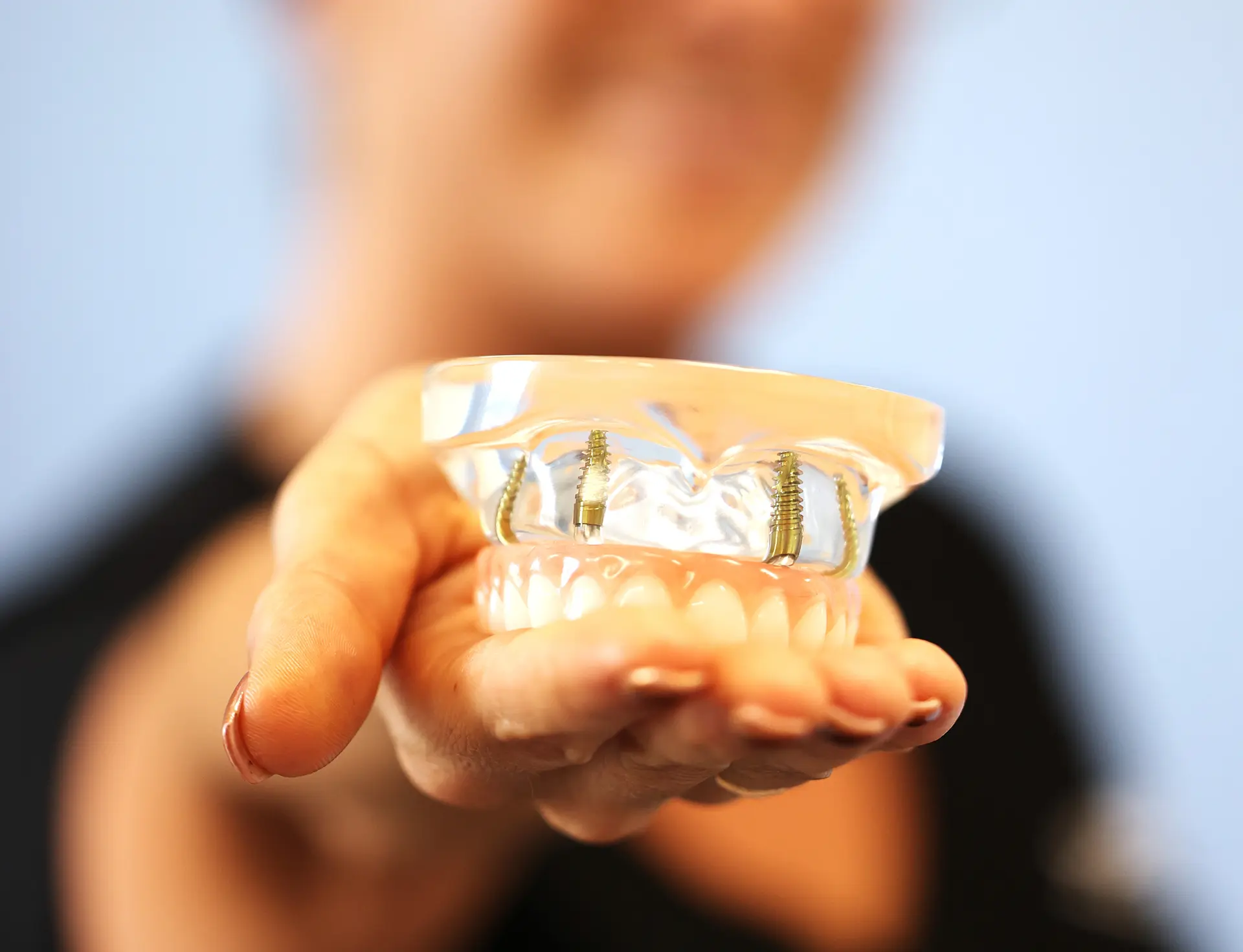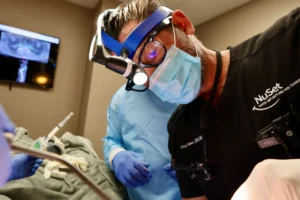Over 60% of adults aged 35 to 44 have lost at least one tooth in America; by the age of 50, the average American has lost over 10 teeth. Dental implants are a great option for replacing missing teeth as they provide a strong base for new teeth, helping you chew and smile with confidence.
The success of dental implants relies heavily on the amount of bone in your jaw. The bone supports the implant and makes sure it stays in place and functions well.
When you lose a tooth, the bone in that area can shrink over time. The bone needs stimulation from the tooth root to stay strong. Without this stimulation, the bone starts to break down. For a dental implant to work, there must be enough bone to hold it securely. But how much bone is needed?
How Much Bone Height is Required for Dental Implants?
For a dental implant to be stable, it needs enough bone height and width. The general guideline is that there should be at least 1 mm of bone around the implant. This includes both the height and width of the bone. This amount helps ensure the implant is secure and reduces the risk of complications.
The height of the bone is especially important. The implant must be fully submerged in the bone. If there isn’t enough bone height, the implant might not integrate properly. This could lead to issues such as the implant becoming loose or failing altogether.
In the upper jaw, bone height is also important to avoid the sinus cavity. If there isn’t enough bone, a procedure called a sinus lift may be necessary. This adds bone below the sinus to create enough height for the implant.
The implant must be placed carefully in the lower jaw to avoid the nerve. Having enough bone height is vital to prevent damage to the nerve, which could cause numbness or pain.
Assessing the bone height and width is a key step in planning for a dental implant. At NuSet, we use advanced imaging techniques to measure your bone accurately. This helps us determine if you have enough bone for an implant or if you need additional procedures to build up the bone.
Bone Augmentation Procedures
When there isn’t enough bone for a dental implant, bone augmentation procedures can help. These procedures add bone or bone-like materials to your jaw to create a solid foundation for the implant.
Bone Grafting
Dental bone grafting is a common method to increase bone volume. It involves taking bone from another part of your body (autograft) or using donor bone (allograft). Sometimes, synthetic materials or bone from animals (xenograft) are used. The graft material is placed where more bone is needed. Over time, your natural bone grows and integrates with the graft, creating enough bone for the implant.
Sinus Lift
As mentioned earlier in the article, a sinus lift is a specific type of bone graft for the upper jaw. If there isn’t enough bone height due to the proximity of the sinus cavity, this procedure adds bone below the sinus. This increases the bone height and provides space for the implant. The sinus lift involves gently raising the sinus membrane and placing the bone graft material underneath.
Ridge Expansion
If your jaw isn’t wide enough for an implant, a ridge expansion might be necessary. This procedure splits the jawbone and inserts bone graft material to increase its width. After healing, there will be enough bone to place the implant securely.
Distraction Osteogenesis
This advanced technique increases bone height. It involves making a small cut in the bone and slowly moving the two pieces apart. New bone forms in the gap, gradually increasing the height of the bone. This method is useful when a significant increase in bone height is needed.
Healing time is essential after a bone augmentation procedure. The graft needs to integrate with your natural bone, which can take several months. Once the bone has healed and is strong enough, the dental implant can be placed. Your dental professional will monitor the healing process to ensure everything is progressing well.
Bone augmentation procedures can significantly improve the chances of a successful dental implant. At NuSet Dental Implants and Oral Surgery, we carefully assess your bone structure and recommend the best approach for your needs. Our goal is to provide you with a stable and lasting solution for your dental health.
Alternatives for Patients with Insufficient Bone
If you don’t have enough bone for a traditional dental implant, there are alternative options to consider. These alternatives can provide a stable solution even when bone quantity is limited.
Mini Implants
Mini implants are smaller in diameter than standard implants. They require less bone for placement, making them a good option for areas with limited bone. Mini implants can often be placed without the need for bone grafting. They are less invasive and have a shorter healing time. However, they may not be suitable for all cases, especially where more significant chewing forces are needed.
Zygomatic Implants
Zygomatic dental implants are a solution for patients with severe bone loss in the upper jaw. These implants are longer and anchored in the cheekbone (zygoma) rather than the jawbone. The cheekbone has more bone volume, providing a strong foundation for the implant. This method bypasses the need for bone grafting in the upper jaw. Zygomatic implants can support fixed dental restorations and offer a stable, long-term solution.
All-on-4 Implants
The All-on-4 uses four strategically placed implants to support a full arch of new teeth. This method often avoids the need for bone grafting by placing the implants at an angle using available bone. All-on-4 implants provide excellent stability and can often be placed in a single visit. They are ideal for patients who need full arch restoration but have limited bone in certain areas.
Subperiosteal Implants
Subperiosteal implants are placed on top of the jawbone but under the gum tissue. A metal frame is fitted onto the jawbone, and posts attached to the frame hold the new teeth. This option is suitable for patients with insufficient bone height or who cannot undergo bone grafting. While less common, subperiosteal implants can still provide a stable solution for tooth replacement.
Bone Grafting Combined with Implants
In some cases, a combination of bone grafting and implants may be the best solution. Grafting can build up the bone, making it possible to place traditional implants later. This approach takes more time but can provide excellent long-term results.
At NuSet Dental Implants and Oral Surgery, we evaluate your specific needs to recommend the best option. Our goal is to ensure you receive a stable, effective solution for your dental health. We are here to help you find the right approach, even if you have limited bone.
How to Maintain Bone Health for Long-Term Success of Dental Implants
Maintaining bone health is crucial for the long-term success of your dental implants. Here are some steps you can take to keep your bones strong and healthy:
Cultivate Good Oral Hygiene
Brush your teeth at least twice a day and floss daily. Keeping your mouth clean prevents infections that can weaken the bone around your implants. Use a soft-bristled toothbrush and non-abrasive toothpaste to protect your gums and implants.
Do Not Miss Your Routine Dental Check-Ups
Visit your dentist regularly for check-ups and cleanings. Your dentist will monitor the health of your implants and the surrounding bone. Regular visits help catch any issues early before they become serious problems.
Eat Healthy
Eat a balanced diet rich in calcium and vitamin D. These nutrients are vital for bone health. Foods like dairy products, leafy greens, and fish are good sources of calcium. Sun exposure and foods like eggs and fatty fish can help you get enough vitamin D.
Avoid Smoking
Smoking can weaken your bones and affect the healing process of your implants. If you smoke, consider quitting to improve the health of your bones and the success of your implants.
Stay Active
Regular exercise, especially weight-bearing activities like walking and strength training, can help maintain bone density. Staying active supports overall health and keeps your bones strong.
Protect Your Implants
Avoid using your teeth as tools to open packages or bite down on hard objects. Protect your implants from excessive force to ensure they remain stable and secure.
Secure Your Dental Implant Success with a Strong Foundation
Having enough bone is vital for the success of your dental implants. The bone provides the necessary support and stability for the implants, ensuring they function well and last long. If you don’t have enough bone, there are solutions available, such as bone grafting or alternative implant options. These procedures can help build up the bone and provide a solid foundation for your implants.
If you are considering dental implants or have concerns about your bone health, contact us. Our experienced team is here to provide you with personalized care and the highest quality treatment.
Frequently Asked Questions
Do I have enough bone for dental implants?
To determine if you have enough bone for dental implants, we will assess the height, width, and density of your jawbone using imaging techniques like X-rays and CT scans. Generally, at least 1 mm of bone around the implant is needed to ensure stability and prevent complications. If you lack sufficient bone, options like bone grafting or alternative implant techniques can help build it up.
How much bone height is needed for a dental implant?
The required bone height for a dental implant varies, but typically, you need enough bone to fully submerge the implant. In the upper jaw, additional bone height may be necessary to avoid the sinus cavity, often requiring a sinus lift. In the lower jaw, sufficient bone height is needed to prevent contact with the nerve.
What is the minimum bone length for a dental implant?
The minimum bone length for a dental implant depends on the type and location. Generally, at least 1 mm of bone surrounding the implant is required to ensure proper integration and stability. Adequate length is important for standard implants to avoid complications such as implant loosening or failure.
Can you get a dental implant with too much bone loss?
Yes, you can. If you have significant bone loss, getting a dental implant is still possible with additional procedures. Bone grafting can add bone to areas with insufficient volume, creating a suitable foundation for the implant. Alternatives like mini implants or zygomatic implants can also be considered for patients with severe bone loss. These options bypass the need for extensive bone grafting by utilizing available bone in other parts of the jaw or cheekbone.





